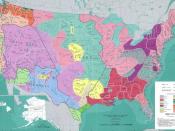After reading the text and evaluating the time lines it is easy to see the Native American culture and beliefs change with each turning page. After the arrival of the Europeans the Native Americans would never be the same. In conclusion, The primary argument that the author was trying to relay to the reader is how the Native American responded to the dramatic changes that were enforced by the Europeans and how the Native Americans coped with these changes.
In the first chapters of this book the author gives the reader information about the native societies. He informs the reader about the type of food that was grown, how there was over 200 languages spoken. Also the type of agriculture that was used compared to the agriculture that we know today. He also in forms the reader about the types of metals that that were used and were not used.
Then the author goes on the talk about the sedentary societies that were established in Central and Southern Mexico. Theses societies seemed to be far more advanced than the societies in the Americas. These imperial societies built pyramids, palaces and temples. Not only were the sedentary people were very engineered based people but very intelligent with numbers. For example, they created highly accurate annual calendars. They had cities with population sizes 10,000 plus and political systems with in those cities. Not only did they have a great political system but they also had a profound and complex religious system. They did not believe in one god but many gods with certain attributes and natural functions. They would also perform human sacrifices and eat the flesh of humans but it wasn't cannibalism because there was very little flesh involved and it was only performed on very special occasions.
The sedentary people...


